Sales Proposal – What It Is, What It Should Include, and How to Create a Template

Every sales proposal is more than just a document – it’s a powerful tool that determines whether a potential client will say “yes” or “no.” A well-prepared proposal not only presents the offer for products or services, but also addresses the customer’s real needs and demonstrates the company’s advantage over competitors.
In practice, this means that managers and sales reps must be able not only to write a sales proposal, but also to personalize proposals and present them in an engaging way. That’s why more and more businesses use tools like Salesbook, which streamline the sales proposal process and allow teams to create a consistent, visually appealing, and fully customized document in just a few clicks.
Why Is a Sales Proposal So Important in Sales?
For many sales teams, the sales proposal is the most critical point in the entire process – it’s the basis on which the buyer decides whether to move forward with the purchase. You might have an amazing product and a great sales team, but if your proposal is unclear, too generic, or doesn’t address the customer’s actual problems, the risk of losing the deal increases dramatically.
That’s why a successful sales proposal should be treated as a strategic tool, not just a piece of paper to sign. It’s a statement designed to convince potential customers that your company truly understands their challenges and provides the most relevant solution.
From a manager’s perspective, maintaining consistency across the entire team is equally important. When each sales rep tries to write a proposal differently, the company loses control over quality, tone, and brand image. Here, modern CRM systems with built-in proposal generators are invaluable — they help standardize content while allowing teams to tailor every offer to each prospective customer and potential client individually.

What Is a Sales Proposal?
Simply put, a sales proposal is a document in which the seller presents an offer for products or services along with the terms of their purchase. It represents the formal step between a sales conversation and the signing of a contract.
To answer the question “What is a sales proposal?” — it’s a sales tool that serves three main functions:
- It presents a proposed solution tailored to the customer’s needs.
- It builds the company’s credibility through clear and professional language.
- It facilitates the buying decision by outlining transparent details, terms, and deadlines.
There’s no single universal template — for example, a sales proposal in the automotive industry will look different from one used in insurance or renewable energy sectors. That’s why flexibility is crucial. Tools like Salesbook make it easy to create customized sales proposals that fit both the industry’s specifics and each potential client’s expectations.

What Should a Sales Proposal Include?
There’s no single recipe for success, but every sales proposal should contain several essential elements. Missing any of them can make your document easy to ignore.
Company and Client Details
The foundation of every sales proposal is the contact details of both parties. A professional sales proposal should include the full name and address of the seller, company registration data, and details about the potential client. This is not just a formality — such information builds credibility and shows that the document was prepared individually.
Product or Service Description
The customer must know exactly what they are buying. That’s why the description of products or services should be clear, specific, and complete. It’s not only about listing product features, but also emphasizing benefits — what problems your service solves and what value it delivers to the buyer.
This is the moment to stand out from competitors and show why your sales proposal is more than standard. If you want to write a great sales proposal, don’t limit yourself to catalog descriptions — highlight the added value.
Price, Payment, and Delivery Terms
Without these, a sales proposal doesn’t make sense. The customer must know the price, payment method and deadline, and delivery conditions. It’s also important to clearly specify the validity period of the proposal — it gives the offer a time frame and motivates the buyer to decide.
Transparency at this point is key. The clearer the terms, the greater the chance the customer will make a purchase decision.
Sales Proposal Elements That Build a Competitive Advantage
This is where the potential client makes their choice. The elements that make a sales proposal more compelling include:
- references and case studies,
- guarantees and after-sales service,
- bonuses or discounts,
- additional services supporting customer care.
Companies that can clearly present value create not just a sales document, but a winning sales proposal that truly increases their chances of closing more deals.
With Salesbook, such elements can be easily incorporated thanks to ready-made modules and templates. Instead of spending time manually editing documents, a sales rep can use a system that allows them to prepare a sales proposal in just a few clicks and send it immediately to the potential customer.
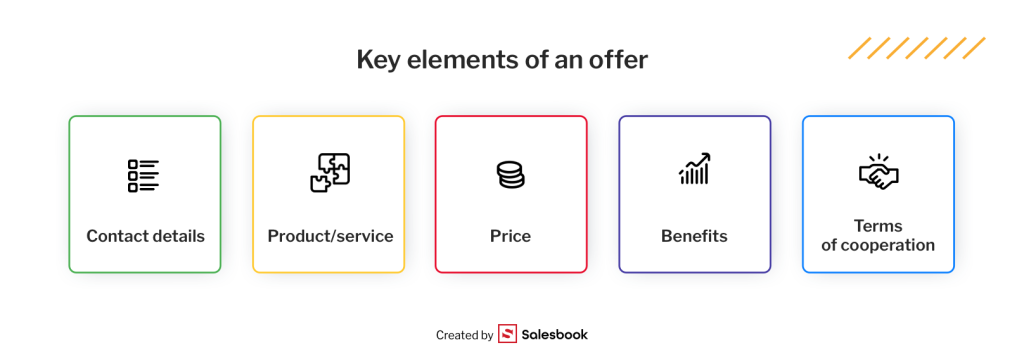
How to Write a Sales Proposal Step by Step
A well-structured sales proposal is not just a document — it’s a sales tool designed to guide a potential client toward making a decision. In practice, decision-makers expect a professional sales proposal before they even start negotiations. That’s why it’s so important to know how to write a sales proposal that stands out from competitors and responds to real market needs.
An effective proposal must be consistent, transparent, and include all the essential elements: the validity period, the proposed solution, payment terms, and a clear benefit for the recipient. Moreover, instead of using generic templates, it’s worth working with personalized content that shows you understand the target audience and their expectations.
In this section, we’ll show step by step how to build the structure of a sales proposal to create a document that converts potential customers into satisfied clients.
Step 1: Analyzing Customer Needs
The foundation of every successful sales proposal is understanding what the customer truly needs. Before you write anything into the document, gather relevant information such as:
- the company’s business goals,
- the challenges they are currently addressing,
- their position compared to industry standards.
Thanks to this research, you can tailor your proposed solution to the client’s real expectations. The sales proposal a representative receives should answer specific questions and eliminate barriers to making a purchase decision.
Pro tip: In Salesbook, the needs analysis happens directly during the meeting, and the data instantly syncs with the CRM system — this streamlines the process, shortens preparation time, and makes personalization effortless.
Step 2: Personalizing Content
Nothing increases the effectiveness of sales proposals like a personalized approach. Personalization means the proposal includes references to the customer’s industry, challenges, and even the language they use.
A ready-made template can serve as a starting point, but the content should always be modified. It’s worth adding:
- references to earlier conversations or notes,
- a detailed description of products or services,
- a clearly stated validity period that motivates the buyer to decide,
- transparent payment conditions.
This approach helps the recipient see value in the document and recognize that it truly addresses their business problems. That’s how you create a truly professional sales proposal.
Step 3: Visual Appeal and Clarity
Content alone isn’t enough — design matters too. Even the best sales proposal can lose impact if it’s hard to read or lacks visual order. Therefore:
- use clear headings and section divisions,
- introduce readable tables and bullet points,
- ensure an aesthetic layout with consistent visual elements.
The structure of a sales proposal should lead the reader from the problem, through the proposed solution, to the next steps of cooperation. The simpler and clearer the journey, the higher the chance of a purchase decision.
A good benchmark is an example of a sales proposal created in a tool like Salesbook — where every document is based on a proper analysis of customer needs and is ready to send or sign instantly. This shortens response time and shows the potential customer that they are working with a partner who is efficient, modern, and professional.
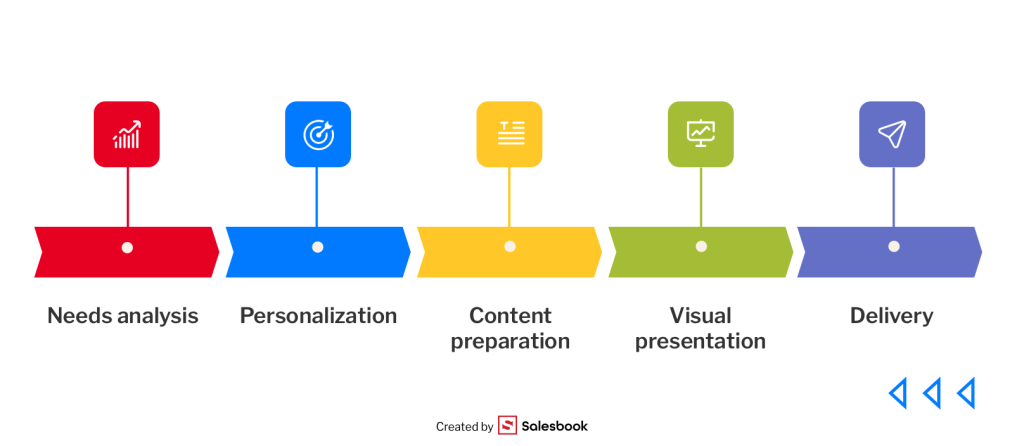
Ready-Made Sales Proposal Template – How It Works in Practice
A ready-made sales proposal template is a huge advantage for sales reps who want to work quickly and professionally. It eliminates the need to create every document from scratch — you simply fill it in with the contact details of a specific potential client, list the offered products or services, and adjust the language and tone to match their needs.
Such a document should include:
- the company’s information and the potential customer’s data,
- a detailed description of the offered product or service with key features,
- payment terms and other essential details,
- a clear list of benefits resulting from cooperation,
- precisely defined conditions that encourage a fast purchase decision.
Remember — the template alone isn’t enough. Your sales proposal must be personalized and show exactly how your proposed solution addresses the client’s challenges. A professional sales proposal doesn’t just present information; it builds trust and demonstrates the company’s credibility and experience gained through cooperation with previous customers.
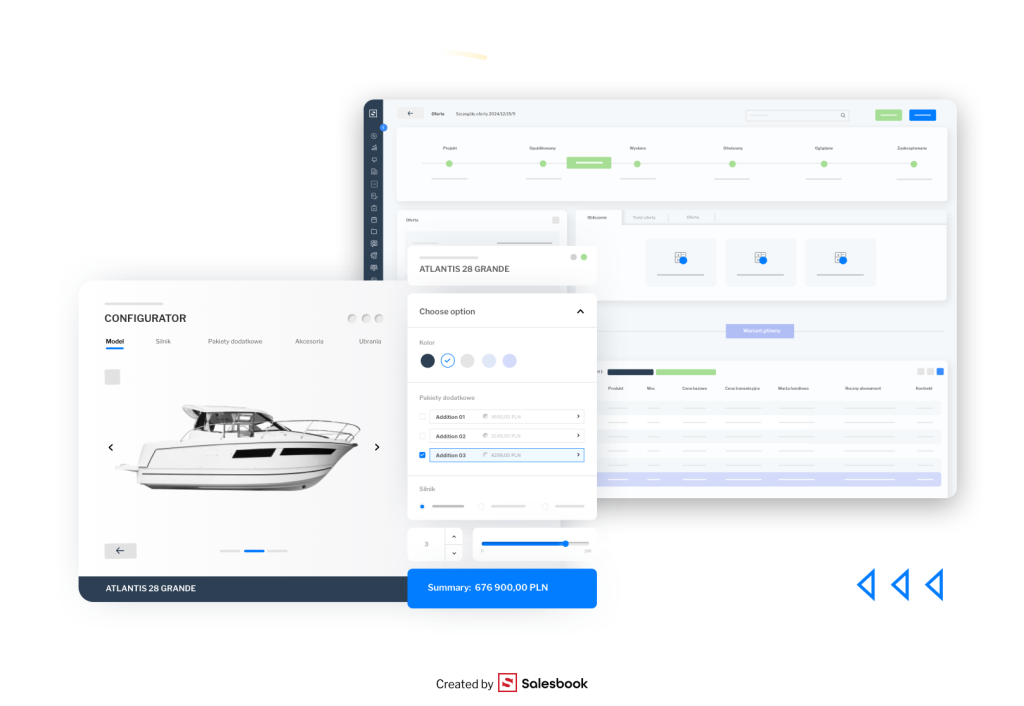
Case Study – Sales Proposals for Different Industries
Automotive
Car dealers must respond quickly to inquiries and build relationships based on trust. A professional sales proposal in this industry includes not only pricing details but also a presentation of vehicle configurations, financing and leasing options, and clearly defined benefits such as lower service costs or access to insurance packages.
Practice shows that personalized proposals and visually engaging presentations of vehicles significantly increase the likelihood that a potential client will decide faster.
Renewable Energy (RES) and Energy Sales
Companies operating in the renewable energy sector often face long and complex sales processes. That’s why your sales proposal must combine technical details with projected savings for the customer. The key elements are: a precise description of the product or service, ROI calculations, and clear terms of cooperation covering service and warranty.
Trust is built by showing experience, client opinions, and visual examples — such as energy consumption or cost simulations. This combination of technical clarity and personalization helps turn prospective customers into long-term partners.
Insurance
In the insurance sector, a professional sales proposal should simplify decision-making as much as possible. Customers want to know what’s covered by the policy, what exclusions apply, and what the price is. Therefore, your proposal must clearly present plan comparisons and highlight the benefits of each option.
This approach makes it easier to convince potential customers that your proposal is fully tailored to their needs and that the terms of cooperation are transparent and trustworthy.
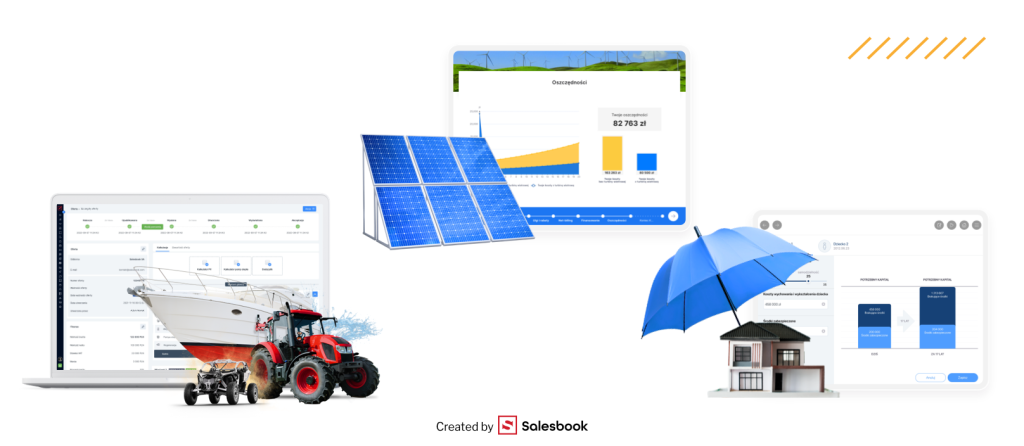
The Most Common Mistakes in a Sales Proposal and How to Avoid Them
- Content that’s too generic – lack of personalization and copying templates.
Solution: tailor the content to the needs of each potential client and target audience. - Unclear terms of cooperation – the customer doesn’t know payment dates, deadlines, or warranty conditions.
Solution: always include all the information and present it clearly in the document. - Too much technical data – overloaded with details and too little focus on benefits.
Solution: highlight real value and show what the proposed solution gives to the buyer. - Poor visual design – the sales proposal looks cluttered or is hard to read.
Solution: use a clean layout, clear sections, and professional visual elements. - No reference to company experience – missing examples or success stories with previous customers.
Solution: add case studies, recommendations, and quotation snippets from satisfied clients to strengthen trust and build relationships.
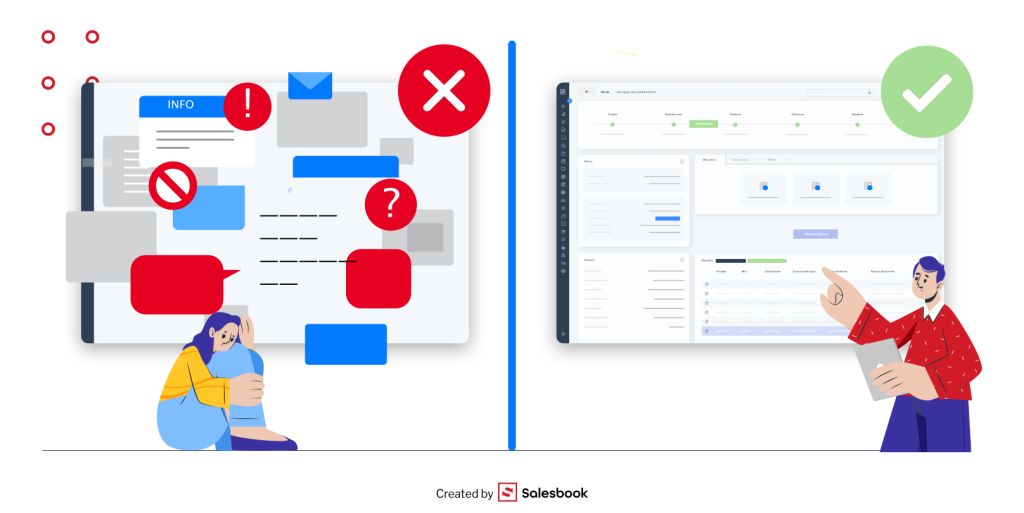
Sales Proposal as a Tool for Sales Team Success
A professional sales proposal is much more than a PDF file — it’s a strategic tool that supports sales reps throughout the entire sales process, from the first conversation to signing the contract. It helps both experienced professionals and young people entering the world of business to communicate ideas clearly, choose the right words, and use every sentence to convince the buyer.
A well-prepared sales proposal:
- addresses the needs of potential customers,
- clearly presents the terms of cooperation,
- highlights specific benefits,
- demonstrates the company’s experience through examples of past clients,
- stands out from competitors thanks to transparency and modern digital tools,
- uses persuasive phrases and precise word choice to keep the reader engaged,
- allows you to discuss not just services, but also individual products in a way that emphasizes value.
When sales reps know how to structure every sentence and select the right words, the sales proposal becomes a story that inspires trust and encourages action.
Want to see how a sales proposal generated in Salesbook works? Explore offer and contract creation and book a free demo to see how easily you can help your team close more deals and build relationships with every potential client.
FAQ – Frequently Asked Questions About Sales Proposals
1. What elements should a professional sales proposal include?
A complete sales proposal usually contains five essential elements — company and contact details, a detailed description of products or services, pricing and payment terms, cooperation conditions, and an overview of the benefits for the buyer. In some cases, an executive summary or short statement can be added to outline the proposed solution. According to best practices recommended by Oxford University Press and Cambridge University Press, clarity and logical word choice are crucial when writing business documents.
2. How many pages long should a sales proposal be?
Ideally, between 2 and 4 pages long — enough to communicate all the information clearly but not overwhelm the reader. Remember to leave a double space between sections and use bullet points to make details easier to read. For quotations or client testimonials, you may use block quotations or direct quotations formatted with quotation marks (or double quotation marks for emphasis), following the conventions of academic writing and professional business documents.
3. How can I stand out from the competition?
Focus on personalizing proposals. Refer to previous customers, examples, and the specific needs of each target audience. Include clear visual elements, case studies, and a story that connects your product features with measurable benefits. Ensure the language is consistent with your brand tone, and if possible, use a title page sales proposal layout to make the presentation more professional and attractive.
4. Should I use a ready-made sales proposal template?
Yes — but treat it as a starting point. Always adapt the content to your industry and potential client’s expectations. Customize the passages, emphasize the meaning behind your offer, and incorporate specific examples that show how your service solves real problems. Good sales proposals use proven practices, clear structure, and relevant information tailored to prospective customers.
5. What are the most common mistakes in sales proposals?
Common mistakes include missing contact details, lack of personalization, unclear pricing, or poor formatting. Avoid long passages without structure — instead, use headings, bullet points, and block quotations to organize content. Make sure your paper has consistent language, correct punctuation (including other punctuation marks), and accurate citations of quoted material if you reference an original source or customer testimonial.
6. How can I measure the effectiveness of my sales proposals?
The simplest method is through conversion rates — how many potential customers or buyers accepted your offer. Advanced CRM tools such as Salesbook let you track performance across the sales process, providing valuable insights into what type of proposals lead to more deals. You can also provide feedback to your team, analyze sales performance, and refine your writing style to achieve even better results in the next project.
7. What makes a winning or great sales proposal?
A winning sales proposal combines clarity, structure, and empathy. It uses a professional presentation with consistent visual elements, precise language, and well-selected examples. The five elements of a great sales proposal are:
- A compelling executive summary,
- A clear proposed solution,
- Transparent pricing and budget,
- Evidence through quotations, citations, or examples,
- A section with next steps to help the buyer decide.
Remember — a sales proposal isn’t just a paper document, but a reflection of your business quality and the values your company stands for. Each well-written proposal strengthens trust, improves cooperation, and ultimately leads to more deals.
Table of Contents







